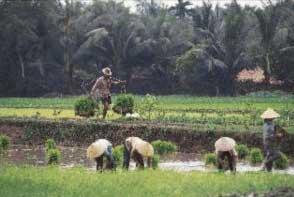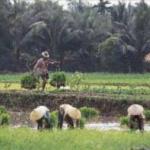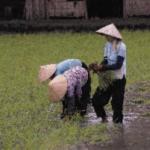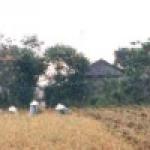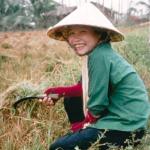Rice
Rice is an integral part of life in Vietnam. The Vietnamese economy depends on agriculture and the main crop is rice. The average Vietnamese eats three quarters of a pound of rice a day. Rice covers 75 per cent of the country's cultivated land and Vietnam has become the world's third largest rice exporter after the United States and Thailand. The Vietnamese even describe their country as shaped like two rice baskets on a carrying pole.
There are thousands of varieties of cultivated rice. Rice is a cereal grass related to oats, rye and wheat. It comes in white, brown, red, black or amber. It can be short and thick or long and thin. Most of the world's rice grows in flooded fields (it needs a constant supply of water) and is called lowland rice. In countries where there is plenty of rainfall, rice may be raised on hills and is called upland rice.
Lowland rice, also known as wet rice cultivation, is the most common type in Southeast Asia and allows for two or three crops a year. Seedlings are raised in nursery beds and transplanted after 25-50 days to a paddy, a flooded field surrounded by a dirt wall. The paddy is filled with two to six inches of water and the seedlings placed in rows approximately a foot apart.
When the leaves of the rice stalks start to turn yellow the paddies are drained and dried in preparation for the harvest. Workers in Vietnam harvest the rice by hand, using knives or sickles to cut the stalks. Then they tie the stalks together and dry them.
Threshing separates the grain from the rest of the plant. Sometimes it is done mechanically and sometimes people or animals trample the sheaves. After threshing the rice is ready for milling. If the rice is not completely dry it is often spread out on the highway to dry in the sun. Milling removes the husk from the kernel. Sometimes the process also strips off the bran layer which contains most of the nutrients. Brown rice still has its bran coat.
Nothing is wasted in the processing of rice. It can be turned into everything from paper to pudding. It's steamed, puffed and flaked. It can be used for noodles, wine, cosmetics and cooking oil. While the kernels are eaten, the stalks are made into straw and used for sandals, hats, baskets, ropes, brooms and thatched roofs. The hulls provide fuel and fertilizer.
Rice is a staple food for half the world's population and its cultivation can be traced back 7,000 years in Southeast Asia. It is a symbol. It's part of ceremonies and offerings. It's one of the most important crops in the world and an important part of Asian culture.
 ThingsAsian
ThingsAsian